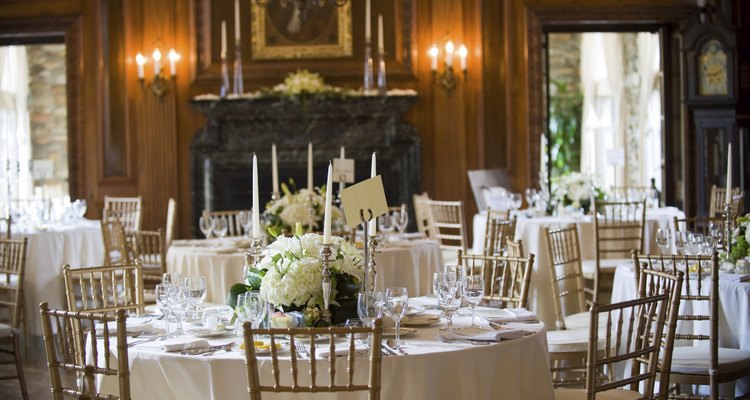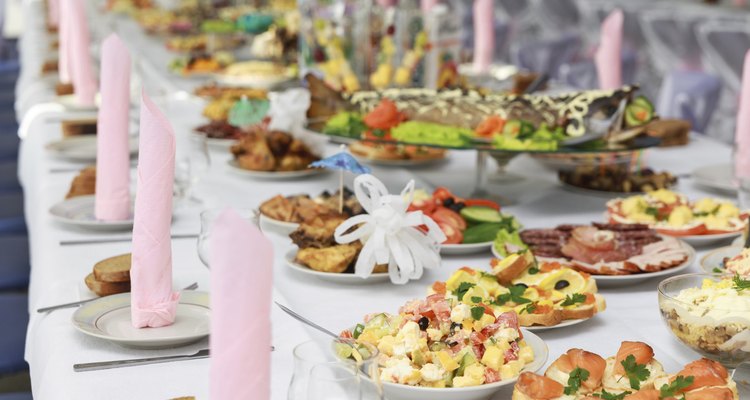
AID/a.collectionRF/amana images/Getty Images
Planning a wedding means more than simply figuring out where you're going to say "I do." A traditional wedding encompasses many stages, from the ceremony to the after-party -- and, in some cases, even includes a rehearsal dinner and next-day brunch. Give each stage of your wedding the attention it deserves by devoting some planning time specifically to each part of the event.
Wedding Ceremony

pojoslaw/iStock/Getty Images
If you skip the rehearsal and its accompanying dinner, the wedding ceremony is the first part of your wedding day to plan. Ceremonies either take a religious or a civil bent, depending on the couple's wishes. To plan your wedding ceremony, you have to make a few key decisions, such as who will marry you -- whether it's a priest, a justice of the peace or someone else. You also have to determine if you want to have any readings and a unity symbol, such as a sand or a candle ceremony. Select pre-ceremony music, processional and recessional music, as well as any songs you wish to play during the ceremony.
Cocktail Hour

amoklv/iStock/Getty Images
After the ceremony, the wedding typically evolves into the cocktail hour, while the couple, bridal party and family take formal photographs. The guests mix and mingle, often with cocktails and hors d'oeuvres in hand while music plays -- whether it's a DJ with a jazz playlist, a single violinist, a string quartet or a full band. Cocktail hours are sometimes, but not always, held in a location adjacent to the reception area. Options include an outside patio or veranda or a grand hall or lobby.
Wedding Reception

tryit4fun/iStock/Getty Images
The actual reception is the most significant portion of a wedding in terms of time. As the cocktails end, the DJ or bandleader asks guests to return to their seats, and the wedding party is introduced, ending with the newlyweds. Sometimes, the couple goes straight into their first dance; in other receptions, the dance is saved until after dinner. If you're having a plated dinner, the salad course is served now, followed by the entree. In a buffet-type meal, the catering staff release tables one by one to go to the serving line. During dinner, a number of special guests might give speeches, including the best man, maid of honor and both the father of the bride and the groom. After dinner, it's time for special dances, including the father-daughter dance and mother-son dance, followed by the cake-cutting. This sweet moment indicates to guests that it's appropriate to leave the reception, though many will stay to dance the night away. Traditionally, at the beginning of a reception, the newlyweds greet guests as part of a receiving line; modern etiquette sees the couples visiting each table during dinner and dancing hours to personally thank each guest for attending. A typically wedding reception lasts anywhere from four to six hours, and the events within are highly variable, based on the preferences and budget of the bride and groom.
Peripheral Events

Aksakalko/iStock/Getty Images
No stage of a wedding is truly "required," but some couples choose to host events beyond the standard ceremony, cocktail hour and reception. The day before the wedding, the groom's parents traditionally host a rehearsal dinner; the guests include the couple, the bridal party and, in some cases, out-of-town guests. This dinner follows the actual rehearsal, in which the bridal party practices where they walk and stand during the ceremony. The rehearsal dinner varies in formality, and can encompass anything from a formal sit-down dinner to a barbecue or a beach clam bake. After the reception dies down, some couples like to keep the celebration going with an after-party. These very casual events often see guests heading to a local bar or friend's home for additional cocktails and, perhaps, a little sustenance. Finally, the day after a wedding, some families throw a brunch to say goodbye to the guests. This can be as casual as a gathering at a restaurant, where each guest pays for his own meal, or a small meal at a home featuring bagels, fruit, juice and coffee.
Related Articles

The Difference Between the Rehearsal ...

How to Plan a Wedding for 25 Guests

The Parts of a Traditional French Meal

Differences Between Chinese and ...

Cake & Champagne Only Wedding Reception ...

Who Pays for an Engagement Dinner?

Spanish Dating, Courtship & Marriage ...

Ways to Serve Dinner at a Wedding ...

What Is the Difference Between a ...

Commitment Ceremony Ideas

Minister Checklist For a Wedding

Wedding Etiquette: Master of Ceremonies

Places to Have a Wedding on Lake ...

Wedding Etiquette for Food Times

Simple Menu Ideas for Small Wedding ...

Commitment Ceremony Etiquette

What Is the Meaning of Family Reunion?

What Traditional Dances Are in a ...

How to Announce a Newly Married Couple

Who Gets Invited to a Wedding Rehearsal ...
References
Writer Bio
Kelsey Casselbury is a freelance writer and editor based in central Maryland. Not only a freelance writer, editor, and designer, she is also a mom of a preschooler, a volunteer for two nonprofit organizations, and an avid reader, cook, and piano player. She has a bachelor's degree in journalism from The Pennsylvania State University.
Photo Credits
AID/a.collectionRF/amana images/Getty Images